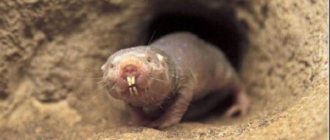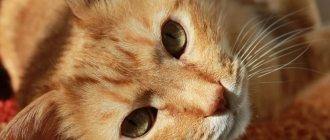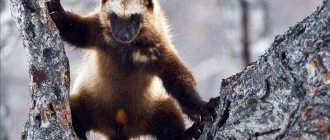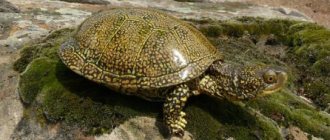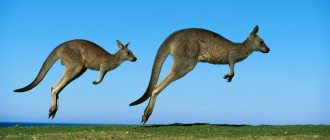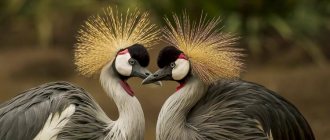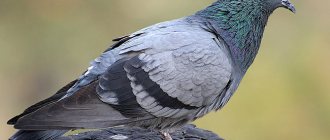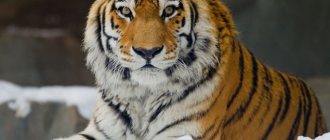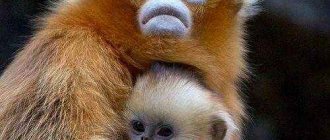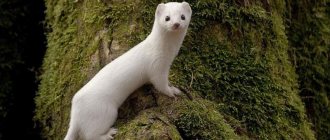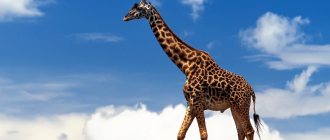The aardvark is one of the truly amazing mammals that live only in Africa, where they are called “aardvark”, which means “earth pig”. Outwardly, this animal resembles a pig with an elongated muzzle, its ears are very similar to those of a hare, and its strong tail resembles that of a kangaroo. What else is unusual about the aardvark?
Mammals
Australia is distinguished by the fact that about 380 species of mammals are found on its territory. This number includes 159 species of marsupials, 69 species of various rodents, as well as 76 species of bats. On this continent there are several orders and families of endemic animals that are not found on other continents of our Planet. These include marsupial moles, predatory marsupials, echidnas and platypuses, monotremes, marsupial anteaters, wombats, koalas, and also the marsupial bear.
Short-faced kangaroo
This animal is also called the Tasmanian rat kangaroo. It represents the “kangaroo family” and, like all kangaroos, has a “bag”. It is named after the naturalist from France Joseph Paul Gemar. Adults grow up to 50 cm in length and no more, with the tail length reaching a little more than 30 cm. The average weight of these animals can be about one and a half kilograms. The appearance and structure of short-faced kangaroos has some similarities with rat wide-faced kangaroos, which are characterized by the presence of a reddish nasal planum, as well as short, rounded ears.
Quokka or short-tailed kangaroo
The habitat of this small marsupial mammal is associated with southwest Australia. The mammal represents the smallest representative of the wallaby. Wallabies are also marsupials and belong to the kangaroo family. Local Australians call this mammal quokka. The quokka is distinguished by a large, hunched back, as well as not so long forelimbs. Males, although slightly, are larger than females and gain weight up to 4 kilograms, and females - no more than 3 and a half kilograms.
Koala
Today, this marsupial is considered the only modern mammal representing the koala family. They (koalas) are more reminiscent of wombats, but at the same time they have a denser coat. In addition, these two-incisor marsupials have large ears and long limbs, armed with fairly sharp claws. The structure of the teeth is designed for a herbivorous diet. The mammal is characterized by noticeable slowness, which is due to the peculiarities of its diet.
Tasmanian devil
This animal is also called the marsupial devil. The Tasmanian devil is a carnivorous marsupial and is considered the only species of the genus Sarcophilus. This animal has a characteristic black coat, a fairly large mouth and very sharp teeth. In addition, the animal makes ominous sounds in the dark and is also characterized by an unfriendly disposition. As a result of a special analysis at the genetic level, it was possible to establish that the marsupial trait is characterized by a close relationship with quolls and a distant relationship with the marsupial wolf thylacine, which, unfortunately, has not survived to this day.
Echidna
The echidna is essentially a small porcupine, since its body is covered with coarse hair interspersed with quills, which are quite sharp. Adults reach a length of about 3 centimeters. The shape of the lips of these animals more closely resembles the shape of a beak.
The echidna, although small, has fairly muscular limbs armed with powerful claws, which allows the echidna to dig the ground without any problems. This unique animal has no teeth and a relatively small mouth. As a rule, the echidna's diet consists of ants and termites, as well as other small invertebrates, which it deftly removes from their hiding places using its long tongue.
Fox body
The animal is also called the brushtail, fox-like glider or common fox. The mammal belongs to the cuscus family. Adult individuals grow up to 60 cm in length, but no more, while the length of the tail can reach 40 cm. The weight of adult individuals is a maximum of 5 kilograms. The tail is both long and fluffy, the main color of which is comparable to the color of the entire coat, being gray or brown. These animals have a sharp muzzle and relatively large ears. It is also possible to meet albinos in nature.
Wombat
These mammals are from the order of two-incisors, which are representatives of the family of marsupial mammals. Their appearance is more reminiscent of fairly large hamsters or even bears, but small in size. They feed mainly on plant foods and prefer to live in burrows. An adult wombat can reach a length of more than 1 meter and weigh about 40 kilograms. The broad-faced wombat is one of the largest representatives of this order.
Platypus
Platypuses represent the order of monotremes and inhabit the waters of Australia. These are unique representatives of the platypus family, which have survived to this day along with echidnas.
In some ways, these animals are similar to reptiles. The mass of adult mammals reaches 2 kilograms, with a body length of no more than 40 centimeters. The length of the platypus's tail is no more than 15 centimeters. The animal has a squat body, armed with short legs and fur. The tail has a flattened shape, which helps the animal feel great in the water element.
UNUSUAL ANIMALS OF AUSTRALIA / TOP 10
Honey badger / 10 unusual animals of Africa
The honey badger is native to Africa, Southwest Asia and the Indian subcontinent. Long white hair covers its back, and short black fur covers its underbelly. He becomes enraged very quickly and is always ready for war, regardless of the size of his opponent: lions, snakes or humans. Built like a wrestler, the honey badger was strongly built, with short, strong legs with five toes and sharp claws. Its skin is very thick and almost impenetrable. They hunt alone or in pairs. Their favorite food is, of course, bee honey, but they eat everything: frogs, snakes, fruits, vegetables. The ability of their skin to stretch approximately 15 cm from their body makes them quite strange.
Birds of Australia
The Australian continent is inhabited by about eight hundred species of all kinds of birds, while more than 300 species are not found anywhere except Australia. The enormous diversity is evidence of the richness of natural resources, as well as the absence of significant numbers of various predators.
Emu
The emu species represents birds of the order Cusuariformes. The bird is quite large and is second only to the ostrich in size. Not so long ago, these birds were classified as belonging to the order Ostrichidae, but in the 80s of the last century, the emu species was classified as a different order. Adult birds grow to almost 2 meters, weighing about 50 kilograms. Thanks to their long legs, emus reach speeds of about 50 km/h. The bird constantly migrates in search of food, covering considerable distances. The bird does not have teeth, so it must swallow stones along with its food along with other solid components that help digest the food.
Helmeted Cockatoo
The bird represents the cockatoo family and is a unique species of its genus. The average body length of a bird is about 35 centimeters and weighs no more than 300 grams. The main color of the feathers is gray, with all feathers ending in an ash-colored border. The helmeted cockatoo's head and crest are a distinctive orange color. The lower abdomen, as well as the undertail, are distinguished by the presence of an orange-yellow border. The main color of the tail and wings is gray, and the beak is lighter in color. Females of this species are distinguished by the fact that their head and crest are colored gray.
Laughing kookaburra
The bird belongs to the kingfisher family and has several other names, such as the laughing kingfisher or the giant kingfisher, as well as simply the kookaburra. The bird belongs to birds of prey and is characterized as a strong bird, with an average body size, the length of which reaches almost half a meter. The bird has a relatively large head, which is colored in gray, off-white, and brown shades. The bird has a relatively large and long beak. The peculiarity of these birds is that they make sounds similar to human laughter.
Bush bigfoot
This Australian bird is a member of the megapod family. Adults of these birds reach a size of about 0.8 meters, with the same wingspan. The Australian continent is home to one of the largest representatives, in the form of the bush megapod. The predominant color of the bird is almost black, but the lower part of the body is colored with light splashes.
A characteristic feature of the species is its long legs, as well as its head, which is distinguished by its red color. At the same time, the legs and head are completely devoid of feathers.
With the onset of the mating season, males are characterized by the fact that their larynx grows in volume, which is distinguished by a bright yellow or bluish-gray color.
Dik-Dik /10 unusual animals of Africa
Is it a deer or a kid? No, it's a species of small antelope called dik-dik. Dik-diks inhabit savannas and bush lands of Eastern and Southern Africa. They are covered with dusty fur, which makes them invisible in the bushes. Their elongated snouts serve to cool themselves when they overheat. Their diet consists of leaves, fruits, shoots and berries. In turn, they provide food for animals such as lions, hyenas, leopards and cheetahs. Dik-Diks have excellent eyesight and run very fast.
Reptiles and amphibians
The Australian continent is characterized by the presence of deserts, which are home to many snakes, including the completely harmless diamondback python, as well as some venomous species such as the pit viper, Australian and tiger snakes, including crocodiles and unique species of frogs. In addition, large areas of the continent are home to many lizards, as well as geckos and monitor lizards, including the unique frilled lizard.
Saltwater crocodile
Saltwater crocodiles belong to fairly large amphibians from the order “crocodiles” and the family “true crocodiles”. The fact that this is not a small reptile is indicated by the fact that crocodiles grow up to 7 meters in length, and their weight reaches 2 thousand kilograms. The saltwater crocodile has a large head and powerful jaws. Juveniles have a pale yellow-brown body color with black stripes or spots scattered throughout the body. In older individuals, the color becomes duller and the stripes become barely noticeable. The body is covered with small oval scales. The tail takes up more than half of the entire length of the amphibian’s body.
Flathead Spadefish
This Australian desert toad is a member of the tree frog family and is an Australian frog. As a rule, the small size of the frog is about 7 centimeters, and the species is characterized by the presence of a relatively voluminous head. In addition, the species is distinguished by the presence of an elementary eardrum, as well as a middle finger on the front paws, which is opposed to the other fingers.
The hind limbs are equipped with membranes for swimming. The upper jaw of the Australian frog has teeth. The amphibian's lungs are well developed and have an impressive volume. The back area is colored greenish-olive, and the belly is almost white. In the throat area you can see many small spots of a greenish tint.
Diamondback python
The python family also includes the Australian diamondback python, which is not a venomous snake. The reptile grows up to almost 3 meters. The Australian diamondback python is endemic to this continent and is therefore not found anywhere in the world except Australia. The python thrives in desert conditions. The python's diet includes small insects and lizards, as well as small birds and rodents, depending on its age. Young pythons hunt during the day, while older individuals are more active at night.
Fat-tailed gecko
Another representative of endemics is the Australian gecko, which is named after the French zoologist. It grows in length up to 15 centimeters, no more, and the body is pink in color. The back and head areas have inclusions of brown tints. The tail is noticeably thickened and characterized by an almost black color. In addition, there are small white spots on the tail and throughout the body. The gecko has relatively large paws. For males, a characteristic feature is the presence of two noticeable formations at the beginning of the tail, as well as femoral pores. These pores are designed to remove musk. The lizard's habitats are deserts and semi-deserts. The lizard exhibits its main activity at night, moving slowly across the surface. During the daytime, the animal rests in its shelters, represented by scatterings of stones or a layer of foliage.
bearded lizard
This lizard belongs to the agamidae family and grows in length more than half a meter. The dorsal area is colored bluish, greenish-olive and yellowish. If the lizard senses danger, its color changes noticeably. The lower part of the body has lighter shades. The shape of the body is cylindrical, and it is covered with many spines of various sizes. In the throat area there are folds of skin that support the elongated area of the hyoid bone. On the back of the lizard there are also long, curved spines.
frilled lizard
This animal also represents the agamidae family, and is the only representative of the genus “Chlamydosaurus”. The total body length reaches 1 meter, with males noticeably larger than females. The body can have a color ranging from yellow-brown to black-brown.
This species specifically stands out due to the presence of a fairly long tail, as well as a fold of skin in the form of a collar encircling the head. The peculiarity of the fold is that it contains quite a lot of blood vessels. This lizard has fairly muscular limbs, armed with very reliable claws.
The most dangerous animals in Australia National Geographic
Fishes of Australia
The territorial waters of the Australian continent are home to at least 4 and a half thousand species of fish, while some species are considered Australian and not found within other continents. About 170 species live in freshwater bodies, with the Murray River being the main freshwater artery.
Australian bracken
It is a species of cartilaginous fish and is included in the genus of eagle rays, as well as the family of eagle rays, representing the order of caudal fishes and the superorder of rays. It is endemic to subtropical waters washing the southern coast of Australia. Typically found within the coastal zone. The pectoral fins, together with the head, form something like a diamond-shaped disk. The snout is more like the nose of a duck, as it is characterized as flat. The poisonous spike is located at the end of the tail. The predominant color of the disc surface is gray-brown or olive-green, and short stripes can be seen on it.
Horntooth
This rather large endemic to Australia is a species of lungfish. Barramunda, as this fish is also called, belongs to the monotypic genus of cattails. This fish grows up to one and a half meters in length, or even more, and weighs about 40 kilograms. The body is protected by fairly large scales, while it looks massive and laterally compressed, armed with very fleshy fins. The body of the barramunda is distinguished by a uniform color, ranging from reddish-brown to bluish-gray, which is lighter on the sides, like the belly area. The cattail prefers to live in areas with slow currents and a predominance of aquatic vegetation.
Salamander lepithogalaxia
This is a freshwater ray-finned fish, which in our time is considered the only representative of the genus "Lepidogalaxias", the order "Lepidogalaxiiformes" and the family Lepidogalaxiaceae. This endemic lives in the southwest of the Australian continent and grows up to 7 and a half centimeters in length. The body is elongated, cylindrical, covered with fairly small and thin scales. The caudal fin has a characteristic lanceolate shape and ends in a noticeable rounding. The upper part of the fish's body is colored in greenish-brown tones, while the lateral parts of the body are lighter, with a large number of silvery spots, including dark spots. The underparts are silvery-white. The fins are almost transparent and invisible. The fish cannot move its eyes, but it can turn its head and bend its neck.
Wide urolof
Another endemic of the Australian continent is represented by the broad urolophus, which belongs to the family of short-tailed stingrays, as well as the order “tail-tailed”. As a rule, it is found at depths of about 4 hundred meters. The diamond-shaped wide disc is formed by the pectoral fins, the surface of which is colored gray-green. Slightly prominent dark lines can be seen behind the eyes. Between the nostrils there is a rectangular fold of skin. At the end of the tail part you can see a leaf-shaped caudal fin. A serrated spine starts from the middle of the caudal peduncle, and the fish does not have dorsal fins.
Common gray shark
This shark species is considered rare. The gray shark belongs to the gray shark family. The shark is found in turbid waters of varying salinity levels with rapidly moving horizons. The shark has a fairly dense physique, colored gray. The snout is short but wide, while the eyes are relatively small. The second dorsal fin is quite large. The structure of the teeth is quite unique, since on the upper jaw teeth grow that have a triangular shape, the edge of which has an ending in the form of teeth, and on the lower jaw the teeth have the shape of spear tips and their apex is equally jagged. Gray sharks grow up to 3 meters in length.
Spotted galaxy
A ray-finned fish that belongs to the Galaxiaceae family. This amphidromous fish spends a significant part of its life in reservoirs with fresh water, while it lays its eggs in river mouths and also in estuaries. After birth, the larvae live in salt water for the first six months, after which the fry return to fresh water. The body is elongated, without scales. The pelvic fin is located in the central part of the abdominal cavity, but there is no adipose fin as such. The caudal fin has some bifurcation. The fish grows to a maximum of 20 cm. The upper part of the body is colored in olive-brown tones, while dark spots and rainbow stripes are noticeable on the body, especially when the fish moves.
Population ecology
Kangaroos live in Australia, on the Bismarck Archipelago, on the islands of Tasmania and New Guinea. Habitats depend on the type of kangaroo. For the most part they live on the plain, where bushes and thick grass grow. They can also be found on the beach. Mountain kangaroos live in mountainous areas, Walabi - in the shroud. Tree kangaroos climb trees.
Kangaroos live in groups and become active at dusk, and during the day they usually rest in the shade. The worst enemies of kangaroos are sand flies . After the rains have passed, countless numbers of them are concentrated near reservoirs where kangaroos come to drink. Swarms of flies swoop down on animals and sting their eyes. Sometimes kangaroos even go blind from these bites.
Spiders of Australia
About 10 thousand species of spiders live throughout Australia, and they are one of the most common poisonous creatures. Despite this, few of them pose a serious danger to human life.
Sydney leukoweb spider
This spider has quite potent venom. In Australia, this spider is considered the most dangerous, especially since it produces a lot of poison. It is also called the funnel-web spider, colored in beige and brown tones. These spiders have an oblong abdomen, and their limbs are striped. The front pair of legs is quite long.
Redback spider
It is found everywhere in Australia, even in densely populated urban areas. Prefers to hide in dry places where the sun's rays do not reach. The spider's venom is potent and affects the nervous system, so it poses a certain danger to people. Due to the fact that the spider's chelicerae are small, its bites are insignificant.
Mouse spider
Adult spiders grow up to 30 mm, while their cephalothorax is quite smooth, and their head rises noticeably above the chest area. The color of the spider depends on the gender of the individual. Although they feed mainly on insects, they sometimes hunt small animals.
Bush vipers
If you are attracted to beautiful things, then you may be very tempted to run your hand along the back of this beautiful creature. Ateri, commonly known as bush vipers, are venomous snakes native to tropical sub-Saharan Africa. The size of the snake varies from 40 to 80 cm. They are covered with scales and come in different colors. They spend most of their time in trees. Bush vipers feed on lizards, rodents, birds, amphibians and other snakes. The bite of such a viper can be fatal. People who are bitten may experience blood clots, swelling and severe pain before dying. So if you happen to encounter one of these snakes, although it's unlikely, don't be fooled by its pretty appearance.
Insects
On the Australian continent, relatively large insects are quite common and pose a certain danger to humans.
meat ant
This type of insect represents small ants that are characterized by very aggressive behavior. Each ant family can have more than 50 thousand individuals. Such families form entire colonies, which can be more than half a kilometer in length.
Sailboat Ullys
This diurnal butterfly has a wingspan of up to 15 centimeters. The main color of the wings is black, with extensive spots of blue or blue on the wings. The tips of the wings have a black border. The lower wings end in tails with a slight expansion.
Cactus moth
This is a small Australian butterfly of a brownish-gray color, with noticeable antennae and legs. The front wings have some differences in the nature of the pattern, as well as due to the presence of small stripes. The hind wings are characterized by a lighter color. The wingspan is within 4 cm.
Okapi / 10 unusual animals of Africa
Okapi looks like a science experiment gone wrong. Although they may seem closely related to zebras, okapi are actually related to the giraffe. Like giraffes, their long neck accounts for most of their 2.5m height. It has a chocolate coat with horizontal stripes and rings on its legs and white ankles.
The few remaining okapi roam the forests of the Democratic Republic of Congo. They feed on leaves, buds, herbs, fruits and mushrooms. They don't make much noise except for the occasional panting and bleating of babies when they are stressed. Their main predators are leopards and humans.
